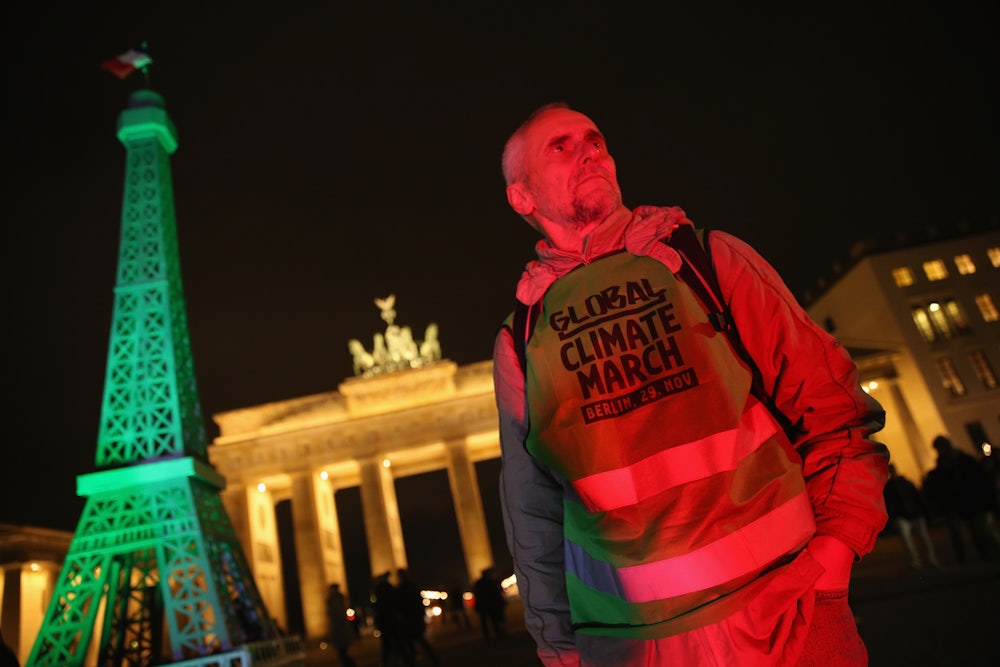The 2015 Paris talks (formally known as the United Nations Framework Convention on Climate Change twenty-first session of the Conference of the Parties and the eleventh session of the Conference of the Parties serving as the meeting of the Parties to the Kyoto Protocol—but let’s just call them the Paris talks) are going to draw about 22,000 official attendees.
Official means negotiators, delegates, diplomats, and aides from 195 countries. That does not include the NGOs, businesses, activists, high school students, and many, many journalists (including me) who will be there to influence, capitalize on, or catalog the two week event. Playing it conservative, total attendance will land around 50,000 people.
Those 50,000 people will come from as far as Auckland, New Zealand and as near as Paris itself. If you add up all the Bangkoks, Bermudas, Cape Towns, Sydneys, Santiagos, Samoas, Jakartas, Singapores, and Stockholms in between, the average distance per traveler is about 9,000 miles, round trip.
Those people will arrive on trains, cars, but mostly airplanes. When flown at full capacity (and the airline industry being what it is, and the Paris meetings being what they are, there’s little reason to think the planes will be anything but packed), a Boeing 747 (a happy medium between private jets and bullet trains) gets about 16.5 miles per gallon of jet fuel. Between 50,000 attendees, that’s about 27 million gallons of the stuff.
When burned, every one of those 27 million gallons of jet fuel releases about 21 pounds of carbon dioxide into the atmosphere. Added up, all those planes flying to the Paris climate talks will release about 575 million pounds of CO2.
Alone, that looks like a really big number. Compared to the entire world, which produces about 80 quadrillion pounds of CO2 each year, it’s not much. In fact, all the travel for all the people to and from Paris equals about 22 seconds of global CO2 emissions. Add in two weeks of hotels, taxis, espressos, pastries, and wine toasts, and you can probably tack on another half second or so.
Keep in mind, this is all back of the napkin stuff. (If you want something more accurate, the UNFCCC plans to release its own calculations soon.) Not perfect, but a serviceable reminder that these talks are not free in terms of raw emissions.
Which demands the question: Will the trip be worth the gas?
The marquee goal of Paris/COP21 is to keep average global temperatures from rising 2˚C. Or at least, it was. It’s pretty clear that currently, the combined commitments from the involved countries fall short of that.
But let’s say the talks work. All the world’s nations come together with a big kumbaya and together, their commitments cut global emissions to less than 1,000 gigatons a year by 2040. Global temperatures do not rise 2˚C. What does that world look like?
Well, it’s no utopia. For proof, look at the world as it is right now. 2015 marks the first year in which global average temperatures rose 1˚C higher than the historical average. Scientists have identified links between that temperature rise and droughts, wildfires, sea creatures dying off from warming waters, and billions of dollars in destruction from sea level rise. All of that keeps happening at 2˚C, except worse and more often.
And like I said, it’s pretty unlikely the Paris agreements will keep the world under 2˚C. “I think pessimism is pretty popular,” says Aimee Barnes, a delegate for the California EPA. Touché. Unsurprisingly, she sees things differently.
Getting to 2˚C is an incremental goal. “Two years ago, nobody thought it would be possible to get 156 emissions commitments from 130 different countries,” she says. That alone signals a commitment to continue working towards the goal. Formerly a climate negotiator, Barnes points to the successes of the 2010 climate talks in Cancún, Mexico, which came a year after the disastrous Copenhagen meeting. “So much groundwork in Copenhagen came to fruition in Mexico. I just remember all of us at 4am in the morning after that last day of negotiations, feeling delirious and tired and maybe like we were on the positive path,” she says.
Another goal of the meeting is to help leverage more money into developing countries, so their economies aren’t reliant on fossil fuels. If successful, the financial talks could lead to more and better commitments from some of the future’s biggest economies, like India.
And then there’s the role of cities, states, and provinces, non-national actors with the economic power to make fast, effective emissions cuts. Take California, which has the world’s eighth-strongest economy and one the globe’s most successful cap and trade programs. That puts some nice weight behind all that optimism.
Optimism, it should be said, is not a great thing to rely on. Climate negotiations since Kyoto have failed, mostly because no nation has the ability to police any other on its promises. In other words, the tragedy of the commons. The only way to get a climate agreement that works, say most, is through some sort of shared incentive.
In other words, a price on carbon. “All countries would agree that they would price carbon emissions at $20 or $30 per ton,” says Steve Stoft, Berkeley economist and author of climateParis.org and carbon-Price.com. Then, countries come up with their own programs—like cap and trade, taxes, or regulations—to develop their economy while meeting that price requirement.
A great idea, with a lot of support from economists (two Nobel laureates have signed on) and negotiators alike (Barnes likes them, too). But carbon pricing isn’t likely to happen at Paris. So what will happen? Incremental progress. Exactly how much is hard to tell, but probably enough to smudge out those 22 seconds of emissions.
Special thanks to Steven Stoft of climateParis.org and carbon-Price.com for his help with the calculations.
This story was originally published by Wired and is reproduced here as part of the Climate Desk collaboration.
